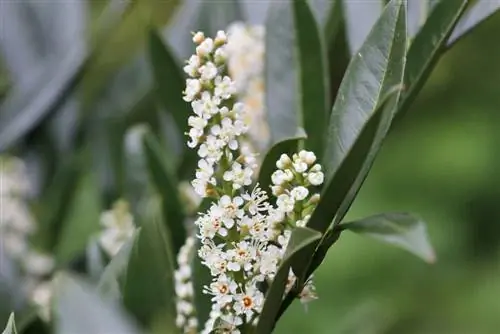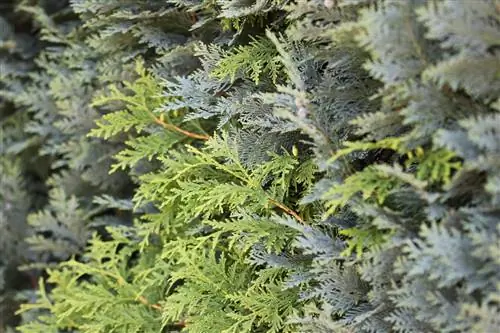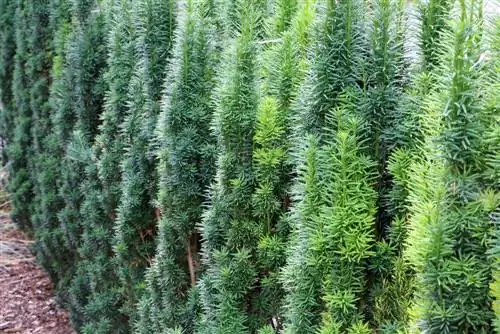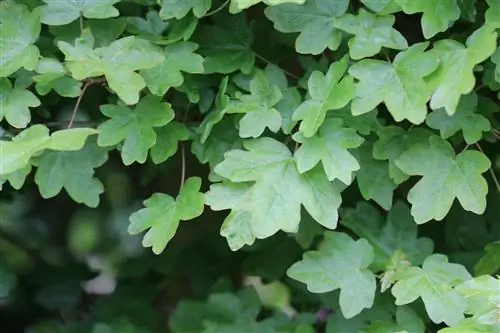- Author admin [email protected].
- Public 2023-12-17 03:39.
- Last modified 2025-01-24 12:45.
A laurel hedge with real laurel plants is only partially hardy. You should consider this before you have numerous laurel plants delivered from the nursery for a hedge. The real laurel (Laurus nobilis) comes from the Near East and the Mediterranean region; it is not used to harsh winters. Colloquially and visually, it is sometimes confused with the cherry laurel, actually the laurel cherry. However, there is no botanical relationship. A hedge made from real laurel looks elegant and is quite easy to care for if the climate is right.
Location
Before purchasing the laurel plants, the suitability of the geographical location should first be clarified. The real laurel can only tolerate a few degrees below zero in winter. A garden in the Rhineland, somewhere on the North Sea or on Lake Constance is therefore well suited for planting a laurel hedge.
In the garden, the Laurus nobilis wants a warm location with lots of sun. But partially shaded areas with sufficient sun in the morning or afternoon are also tolerated. It is best to have a location protected from the wind so that it is not exposed to the cold winds in winter.
Floor
The better the soil conditions are adapted to the requirements of the laurel, the he althier it will survive the winter and will forgive negligence when watering and fertilizing. The ideal soil for a Laurus nobilis hedge is:
- sandy, humus
- permeable and structurally stable
- weaklysour
Compacted soil that tends to become waterlogged is not suitable and would have to be thoroughly prepared before planting.
Pouring
Depending on how well the site and soil conditions are met, you don't have to worry too much about water and nutrients. The roots should never dry out completely. Accordingly, the hedge must be watered sufficiently in dry and sunny periods. Since the laurel is somewhat tolerant of lime, the hedge can be watered with a hose. Even in dry, frost-free winter periods: don't forget to water.
Fertilize
The laurel hedge only needs a little additional fertilizer. The roots of the spice laurel are very sensitive to s alt. Fertilizers based on mineral s alts are therefore not so suitable. It is best to only use natural long-term fertilizer, such as compost, manure or molasses-based fertilizer. Fertilization is therefore carried out sparingly and if so, then in the growth phase between April and August.
Planting
For a laurel hedge, count two plants, approx. 40 - 60 cm high, for one meter of hedge. Subsequently, gaps can be filled in with cuttings. In addition, the laurel also reproduces via root runners.

Good soil preparation is important. The soil must be loosened generously. If necessary, particularly loamy and stony areas can be replaced with loose, sandy soil. The roots are relatively delicate and you should give them the opportunity to easily root into the soil and branch out well.
- best planting time: spring or autumn
- Water the root ball beforehand (until no more air bubbles escape)
- mark the route of the planned hedge with a string
- Dig planting holes (distance approx. 50 cm)
- at least twice as deep as the root ball
- fill in a mixture of compost, manure and garden soil
- Insert plants up to the visible edge of the soil
- fill with sand and soil mixture
- Press earth
- water well, but do not cause waterlogging
- Place a layer of mulch (made of straw) on top to prevent drying out and weeds
Tip:
If the plants are already one meter or higher, it is advisable to provide them with a support in the first year for straight growth.
Propagation
If you would like to put in a little more effort and also want to save money on a long hedge, you can also propagate the spiced laurel yourself. Propagation through cuttings promises the quickest and most success. But it is also possible to grow from seeds or root runners. The real laurel can also be propagated by lowering it, but it will be quite difficult to lower it if there is an existing hedge planting. There are easier ways.
Cuttings
To do this, cut off half-ripe branches from the Laurus nobilis. These are then cut from the tip to a length of 10 to 20 centimeters. Young, fresh shoots are not suitable for this. Remove the lower leaves; four or five leaves are enough.
Then you put them in a growing substrate to root. Roots form more quickly when the climate is humid. This can be achieved, for example, with a transparent film. Don't forget to ventilate daily to avoid mold formation.
It takes around six months for sufficiently strong roots to form, then they can be placed outdoors, ideally from spring onwards.
Even in a container with water, possibly with a few drops of rooting aid, the cuttings will root sooner or later.
Root runners
Sometimes roots form on the ground, not always in the desired location. These runners can then be cut off with a piece of the root. Now let them form more roots in a pot outside in a sunny spot. Make sure there is enough moisture in the soil at all times.
Seeds
As is always the case when growing from seeds, this type of propagation takes a long time, even with true laurel, but is quite uncomplicated if you have enough patience.
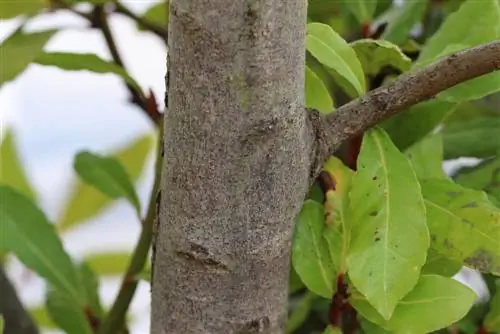
You can buy spiced laurel seeds in stores. If you want to try using your own laurel seeds, you need older female plants that produce flowers. They also need to be pollinated. To do this they need a male plant nearby. Fertilized flowers produce small, black-blue berries in late summer. Then you can get started:
- Remove the seeds from the ripe berries
- Soak the fresh seeds in water for up to two days
- not soaked, it takes a little longer to germinate
- Press seeds into potting soil or sand
- 0, 5 to 1 cm deep
- Ambient temperature 20° C
- Keep substrate moist
- Germination after approx. 20 days
- when the first real leaves have formed, place them individually in pots
- grow it there until stable plants emerge
- plant outdoors in spring
Wintering
The spice laurel is quite sensitive to frost, but in the temperate regions of Germany it can survive temperatures down to -10°C in the short term. However, things get tight during longer periods of hard frost. Anyone who has planted a laurel hedge will hopefully not have planted it in the Harz or Alpine regions.
Tip:
Brown, dead leaves after winter do not have to be frostbite. This is usually due to drought damage caused by too little water in the winter period. Pruning promotes new growth.
Cutting
No question, even a hedge with real laurel must be kept in shape. A laurel hedge trimming with a motorized hedge trimmer rightly causes a stomach ache just watching it. Many pretty spice leaves are simply cut through, so to speak injured. The result is brown, unsightly leaf fragments and increased susceptibility to disease. So: If you love your Laurus nobilis hedge, cut it manually with hedge trimmers or secateurs.
- The hedge trimming for the real laurel is done twice a year
- Winter cut (November to March)
- Summer pruning (first half of June, before budding)
- prune any damaged, disruptive or too tall shoots individually
- Cutting errors are quickly compensated for by rapid sprouting
- Use the opportunity for cuttings during the section
- and don’t forget the spice supply
Species
In the laurel genus (Laurus), in addition to the Laurus nobilis, the Azores laurel (Laurus Azorica) and the Laurus Novocanariensis are also known here in Germany: However, they are not as present in garden centers as the Laurus nobilis.
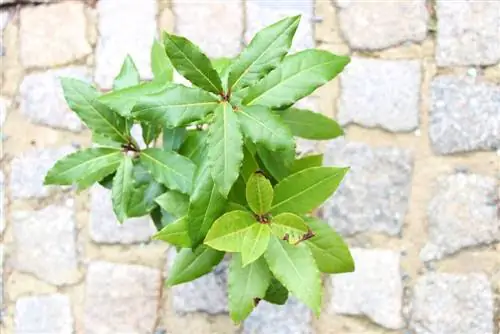
Both species reach an impressive height and have evergreen, aromatic leaves. The leaves of the Azorean laurel are somewhat felty on the underside and do not have as strong an aroma as the leaves of the spiced laurel.
The Laurus Novocanariensis produces fragrant creamy white flowers. Its shiny, dark green leaves are even more delicately aromatic than those of Laurus nobilis.
Diseases, pests
With this beautiful leaf, unsightly, brown leaves are twice as noticeable. Fortunately, the real laurel is quite robust and not very susceptible to pests and diseases. The essential oils that make it so valuable as a kitchen spice offer quite good protection against predators.
If so, then it is predominantly potted crops that are attacked by scale insects and spider mites in their winter quarters.
Brown or yellow leaves on the hedge are usually caused by care errors or persistent unfavorable weather. Long dry periods or waterlogging weaken the leaves of the laurel, they become unsightly and then fall off.
Toxicity
If the real laurel were poisonous, humanity would probably have wiped itself out long ago. Its leaves have been refining soups and meat dishes for centuries with their slightly bitter, spicy aroma.
Tip:
In autumn and spring the leaves have the most essential oils. A perfect time to cut and dry some leaves for the kitchen.
With almost any spice, too much can lead to unwanted side effects. As with nutmeg, bay leaves can also cause impaired consciousness if consumed excessively.
The spice laurel is sometimes confused with the cherry laurel (Prunus laurocerasus), not just in name. However, this is poisonous in all parts of the plant.
Conclusion
If you are lucky enough to live in one of Germany's temperate climate zones, you can afford the luxury of a wintergreen Laurus Nobilis hedge. It is robust, easy to grow and easy to care for. Only the cut should be done manually, for the sake of the beauty and he alth of the laurel hedge. The leaves, which are available for the kitchen at any time, provide an extra.


